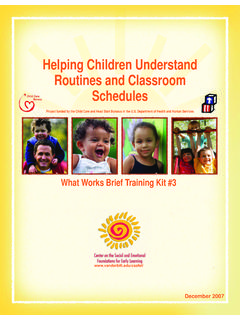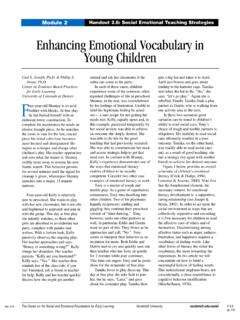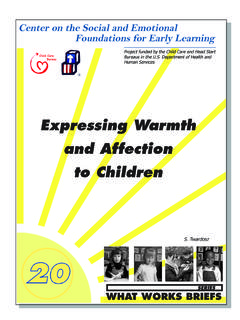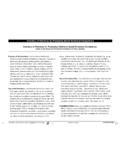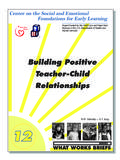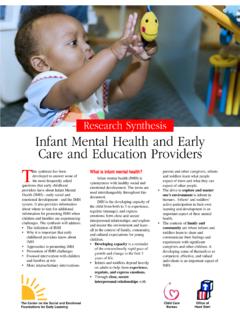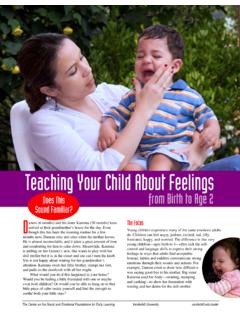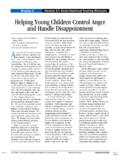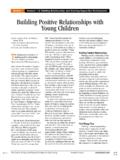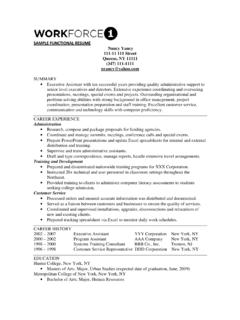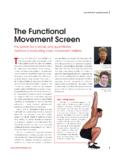Transcription of Using Functional Communication Training to …
1 Center on the Social and Emotional Foundations for Early Learning Project funded by the Child Care and Head Start Bureaus in the Department of Health and Human Services Using Functional Communication Training to Replace Challenging Behavior G. Dunlap M. Duda SERIES. WHAT WORKS BRIEFS. Using Functional Communication Training to Replace Challenging Behavior This What Works Brief is part of a continuing series of providers and others who conduct staff development short, easy-to-read, how to information packets on a activities should find them especially useful in sharing variety of evidence-based practices, strategies, and information with professionals and parents. The Briefs intervention procedures. The Briefs are designed to include examples and vignettes that illustrate how help teachers, and other caregivers support young practical strategies might be used in a variety of early children's social and emotional development.
2 In-service childhood settings and home environments. of doing, (2) can be taught very easily, (3) will be easily noticed Mark's Story and acknowledged whenever the child uses it, and (4) works Mark, a 3-year-old boy, is bright and energetic. He enjoys quickly for the child. The replacement behavior can involve participating in activities that involve numbers and letters; speech, gestures, signs, or pictures, as long as it is something reading picture books; and playing with blocks, cars, and readily available and appropriate to the child's developmental level. For example, replacement behaviors might include having trucks. Mark's Communication skills, however, have been the child communicate messages such as I'm hungry, I'm tired slow to develop. After many attempts to encourage him to and want to take a break, May I play with that toy? No, thank speak more in class, Mark's teacher, Ms.
3 Blake, and his you, or Please help me. The child can communicate these peers have nearly given up. An additional concern has been messages through a variety of means such as Using words or signs an increase in episodes of disruptive behavior. When Mark or pointing to pictures. doesn't get a toy that he wants or when he is asked to share a toy with others, he tends to scream, cry, tantrum, or bite Ms. Blake and Mark's parents were very concerned about other children. When these behaviors happen, Mark's peers Mark's behavior at school. They discussed the problem at get upset and run away from him, and Ms. Blake takes away length. Ms. Blake said, We'll need to conduct a Functional his toy. This outcome often makes Mark's tantrums worse. behavioral assessment to learn the function of Mark's However, Ms. Blake has noticed that when Mark gets the toy behavior. In other words, we will be trying to figure out what that he wants or is allowed to play alone, he does not exhibit Mark is trying to tell us.
4 She continued by saying, I'll these kinds of behaviors. Ms. Blake has also noticed that gather some information, observe Mark at different times of Mark's tantrums occur at times when he is asked to do the day, and ask you some questions. Then we can use that something that is hard for him. information to better understand why Mark is having so much difficulty playing with his friends. Mark's father agreed that it would be a good idea and added, We really What Is Functional Communication Training ? need to know exactly why Mark is doing this.. Functional Communication Training (FCT) is a strategy for use with children who require a more individualized intervention Once a replacement behavior is selected, FCT involves ignoring approach because they continue to exhibit challenging behaviors the challenging behavior and prompting and acknowledging the even when classroom-wide prevention strategies are in place (for use of the replacement behavior.)
5 When Using FCT, it is important example, classroom rules, consistent schedules, predictable to remember several things: routines). FCT involves identifying the function or purpose of the 9 Take advantage of natural opportunities to encourage and child's challenging behavior (for example, hitting, screaming, acknowledge the replacement behavior (for example, pay taking toys away from others) and then teaching an appropriate close attention to Mark, and prompt him to ask for help when behavior that will serve the same purpose for the child. This the behavior is triggered, rather than waiting until Mark begins behavior is referred to as a replacement behavior. For example, to hit to then prompt the new behavior). adults might teach a child who hits his peers when he needs or wants something to instead use his words to ask his friends for 9 Make certain that all of the child's new communicative requests are honored.
6 Especially early on, it is vital that Mark help. While the challenging behavior is often disruptive or is given assistance each time he requests it. For FCT to be aggressive, such as a tantrum, the replacement behavior should effective, the new skill should work better for the child than involve speech or some other type of appropriate Communication , the old challenging behavior. If the challenging behavior such as pointing or gesturing. works better (for example, Mark gets what he wants more efficiently by hitting), the child is more likely to revert to How Does This Intervention Work? Using the challenging behavior rather than the replacement FCT requires that a Functional behavioral assessment be conducted behavior. However, if the new replacement behavior works (see What Works Brief #9 on Functional Behavioral Assessment) to more efficiently, then the child is more likely to use this new identify the function of the child's challenging behavior (for skill.)
7 Example, getting attention or escaping from an activity). After the function or purpose of the challenging behavior is identified, the 9 Be persistent with the intervention. Initially, the child might next step is to determine a more desirable or acceptable form of use the challenging behavior more often. It is important to Communication for the child to use as a replacement for the continue to be consistent until the child understands that the challenging behavior. This replacement behavior, or new form of new skill will be useful in obtaining what he wants. Communication , should be something that (1) the child is capable July 2004. An important principle of FCT is that the replacement behavior be to challenging behavior. As always, when implementing any at least as effective as the challenging behavior in terms of the strategy, teachers must take care to make necessary adaptations child getting what the child wants.
8 Therefore, the replacement to meet the individual, ethnic, and cultural differences of the behavior should be obvious and regularly rewarded by staff, children in their care. parents, or other caregivers. What Behavioral Changes Can Be After several observations, Ms. Blake found that when Mark was required to share a preferred toy he was unable to Expected? communicate his frustration. Instead, Mark communicated his Changes in the amount of challenging behavior can be expected frustration through tantrums and biting. Ms. Blake also found in a fairly short time, although the complete replacement of the challenging behavior with a more desirable or acceptable that Mark's tantrums were more severe when he was not given behavior may take weeks or longer. This time frame will depend a prompt or advance warning that he would need to share a on the efficiency with which the replacement can be taught, the toy or play with something different.
9 Ms. Blake and Mark's consistency with which FCT is implemented, and the length of parents then met to discuss his strengths and Communication time that the child has engaged in the challenging behavior. skills. They agreed that Mark's verbal Communication was slow in developing so, at first, an efficient form of communica- What Can Adults Do? tion should probably involve something visual, such as a cue If a child is consistently exhibiting challenging behavior, there card, to support his speech. Although everybody wanted to are some important things you can do. encourage Mark's speech, they decided to take advantage of his interests in the alphabet and early reading. Therefore, the 9 First, conduct a Functional behavioral assessment (see What initial replacement skill would be cue cards that Mark could Works Brief #9). Not only is it important to define what hold up to indicate his requests for assistance in obtaining a challenging behaviors look like, but it is also important to try to understand the function or purpose of the behavior.
10 Toy or completing a difficult activity. At the same time, Mark Step back and look for patterns in the child's behavior by would be encouraged to use his speech for the same purpose. asking the following questions: What was the child doing before exhibiting challenging behavior? What happened What Resources Are Needed to Use FCT? after? What did the child get or avoid from exhibiting Although some situations may vary, few or no additional resources challenging behavior? These types of questions will help are needed to use FCT. The important things are to identify what identify the purpose of the behavior. the challenging behavior looks like, identify the purpose of the 9 Second, identify the child's skills, especially communica- challenging behavior, recognize the child's strengths and weaknesses, tion skills. During what activities is the child most success- and make certain that staff (and/or family) time is available to imple- ful?
